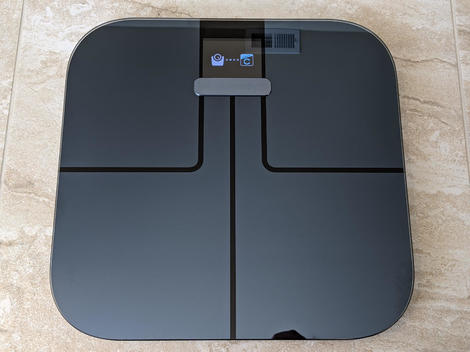I’ve always been in the higher percentile for size and weight with the default charts always showing me as obese. I ignore these charts since I fit comfortably in size 36 pants, I can still see my feet when I stand up, and I can go out and run 10 miles at any time. That said, I have a goal to get back down to my college weight in the next few months, which is a loss of 15 pounds.
Running is my primary form of exercise and I am outside in all weather conditions two or three times a week, generally with the Garmin Forerunner 945 strapped to my wrist. For the past few weeks I’ve been testing the Garmin Index S2 smart scale. It’s proven to be a reliable scale and in addition to your weight it provides several body composition figures, but all of this comes at a rather high price.
Also: Best GPS sports watches in 2020: Coros, Garmin, Polar, and other smartwatches
Over the past few years I have used the Fitbit Aria 2 and Polar Balance scales. These were $100 to $130 at the time of launch, but now we see Fitbit with a $50 scale in the Aria Air and other WiFi scales in a similar price range.
Specifications
Display: 1.2 inch (30.4mm) 240×240-pixel resolution transflective memory-in-pixel color Corning Gorilla Glass DXWeight limit: 400 poundsConnectivity and sensors: WiFi, Bluetooth, ANT+Battery life: Up to nine months with four AAA batteriesDimensions: 320 x 310 x 28mm and 2.0 kg
Hardware
The Garmin Index S2 smart scale is available for $149.99 in black and white. Garmin sent along the black one to evaluate. The retail package includes the four AAA batteries and feet to use the scale on a low carpet surface.
Before inserting the batteries and setting the scale up with the Garmin Connect software on your phone, flip it over to select the units you prefer. You can choose from stones, kilograms, or pounds.
Top ZDNET Reviews
The front of the Garmin Index S2 is all glass with a few lines for the four quadrants. There is a silver plate with the name Garmin on it and a small vibrant color display above the plate centered on the scale. The color display is one improvement over the previous Index scale.
The glass surface collects dust, hair, and other materials in the space where you store and use your scale. I typically wipe it off once a week with a towel or washcloth to keep it clean. However, the glossy black finish looks great when clean.
The color display looks great and shows very large numbers for your weight and various other body measurements. A plot of your weight history can also be shown and ended up being one of my favorite visuals to quickly see if I was trending down or up in my weight.
See also: Garmin Forerunner 745 review: A smaller, lighter option for runners and triathletes
Garmin Connect software
The Garmin Connect smartphone software is used to setup the scale and includes options such as naming the person, up to four characters, weighing in. You can have up to 16 total people using the scale so that should cover most households.
After setting up the scale, you have another cool option for the Index S2. Tap on the widgets option and then you can select exactly what you wish to appear on the scale display. All of this data will be captured and appear in the weight section of the Garmin app, but only the data you select will appear on the scale. By default, all widgets are enabled.
In addition to your weight, you can choose to show the following:
Weight trend: 30 days of weigh-ins shown on a trend lineWeather: A summary of today’s forecast with icons for weather conditionsBody mass index: Body mass as it relates to your heightBody fat percentage: Percentage of your mass made up of essential and stored fatSkeletal muscle mass: Measure of muscle on your body to track if you are building it up or notBone mass: Check the weight of your bone massBody weight percentage: See what percent of your total mass comes from fluids. One method to check your hydration before and after a workout.
Body impedence measurements and Garmin algorithms are used to calculate these body metrics. I haven’t had these metrics measured using methods from a doctor or health professional so do not know how accurate these measurements are. However, for me they are most important to see how they change over time as I work to lose weight and improve my cardio fitness and strength. Trends are easy to view in the Garmin Connect app where you can view the data captured by the scale in day, week, month, and year periods.
Also: Garmin Forerunner 945 review: Music, mapping, payments, pulse, and incident detection
Daily usage experiences and conclusion
One thing that is a bit frustrating with this scale is that you have to move it or pick it up a bit and set it down to turn it on to weigh in. Simply stepping onto the scale doesn’t turn it on and initiate a weigh-in session.
Weight and body composition information is measured quickly with the results appearing on the display after just a few seconds of standing on the scale. The weight closely matches the readings from the Fitbit and Polar scales I have too. I love that the weight syncs up to my Garmin account via WiFi and doesn’t require that I have a watch nearby to record the weight. I also switch watches quite a bit as I test things out, but syncing to my Garmin account then syncs to Apple Health and other services too.
I’m a fan of smart scales that let me stand on them and then sync that data to a source I can refer to later and WiFi scales are definitely my preference. I turned off many of the body metrics since I don’t find all of them useful as they rarely change for me. However, the weight trend plot, weather, and muscle mass are interesting to see on the Garmin Index S2 scale.
$150 is a fairly high price for a connected scale, despite all of the available body metrics and color display. I would be willing to pay up to $100 for a reliable scale. You may have to be a major Garmin fan to justify the Index S2, but it works well and looks good in the bathroom.



